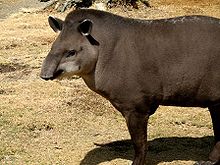South American tapir
This article needs additional citations for verification. (November 2007) |
| Brazilian Tapir | |
|---|---|

| |
| Scientific classification | |
| Kingdom: | |
| Phylum: | |
| Class: | |
| Order: | |
| Family: | |
| Genus: | |
| Species: | T. terrestris
|
| Binomial name | |
| Tapirus terrestris (Linnaeus, 1758)
| |
The Brazilian Tapir (from the tupi tapi'ira), or Anta in Portuguese, also known as the Lowland Tapir (Tapirus terrestris) is one of four species in the tapir family, along with the Mountain Tapir, the Malayan Tapir, and the Baird's Tapir. It is the largest wild land animal in South America.
Appearance
It is dark brown in color and has a low, erect mane running from the crown down the back of the neck. The Brazilian Tapir can attain a body length of 1.8 to 2.5 m (6 to 8 ft) with a 5 to 10 cm (2 to 4 in) long tail and 270 kg (595 lbs) in weight. It stands somewhere between 77 to 108 cm (2.5 to 3.5 feet) at the shoulder.
Range
The Brazilian Tapir can be found near water in the Amazon Rainforest and River Basin in South America, east of the Andes. Its range stretches from Venezuela, Colombia, and Guianas in the north to Brazil, Argentina, and Paraguay, in the south, to Bolivia, Peru, and Ecuador in the West.
Behavior

The species are excellent swimmers and divers but also moves quickly on land, even over rugged, mountainous terrain. The species has a life span of approximately 25 to 30 years. In the wild, the main predators of the Brazilian Tapir are crocodilians and large cats such as the Jaguar and Cougar, which often attack the tapir at night when they leave the water and sleep on the riverbank. They are known to run to the water when scared.
Diet
It is a herbivore. Using its mobile snout, this tapir feeds on leaves, buds, shoots, and small branches that it tears from trees, fruit, grasses, and aquatic plants.

Endangered status
Dwindling numbers are due to poaching for meat and hide, as well as habitat destruction. The Brazilian tapir is generally recognized as an endangered animal species, with the species being designated as endangered by the United States Fish and Wildlife Service on June 2, 1970. The Brazilian tapir, however, had a significantly lower risk of extinction than the other three tapir species.
References
- Template:IUCN2006 Database entry includes justification for why this species is vulnerable
External links
- ARKive - images and movies of the lowland tapir (Tapirus terrestris)
- Tapir Specialist Group - Lowland Tapir

